This confit de canard recipe, or duck confit, is a traditional French way of duck legs in duck fat. Follow our step-by-step instructions for perfectly tender and crispy confit duck legs.
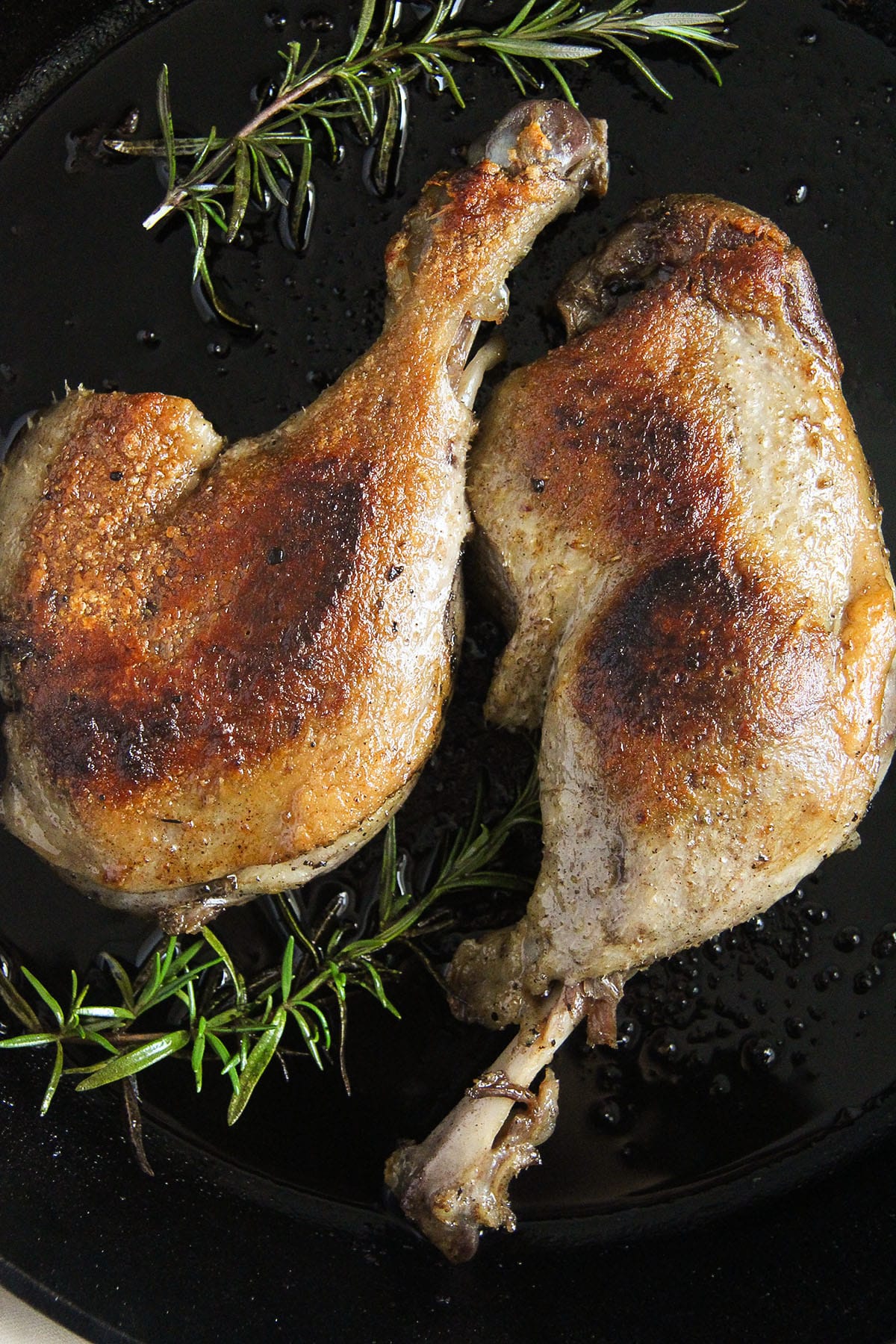
With crispy skin and melt-in-your-mouth tender meat, this confit de canard recipe is truly amazing! Making this dish is easier than you might think. Just follow our detailed step-by-step guide, and you won't have any trouble.
I love eating duck! A roasted duck that my mother-in-law occasionally makes for us, pan-fried duck breasts with braised German red cabbage and crispy cast-iron skillet potatoes, slow-cooked duck legs, duck leg ragu...
So, I know my way with duck. And this duck confit recipe is amazing! No kidding! That fall-off-the-bone tender meat and that slightly salty crispy skin - it is just incredible!
Jump to recipe
What is confit de canard?
Duck confit (tab opens in a new tab) or confit de canard is a French dish originating in Gascony. (Think D'Artagnan and Alexander Dumas; I must have read The Three Musketeers about 20 times when I was a child.)
Confit is a century-old way of preserving meat in fat, and it is not only typical for France, but for other parts of the world as well. I still remember the huge jars full of pork pieces and lard that my grandmother would keep in the pantry.
Try another French duck recipe, this incredible Duck in Orange Sauce.
Recipe ingredients
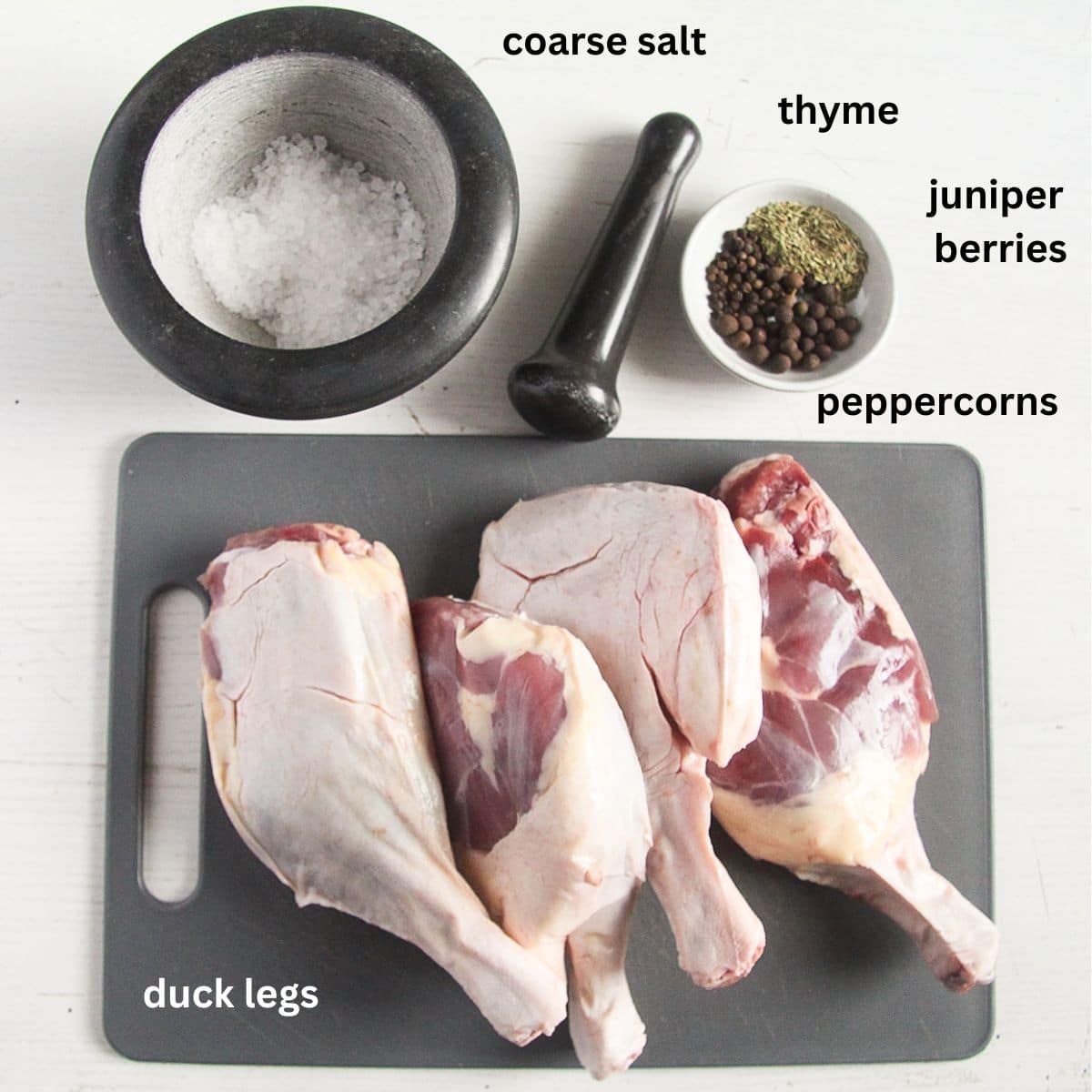
Duck legs, which are the lower leg and the thigh of the bird. Traditionally, the recipe was made using the whole duck, but nowadays, using only the legs is a more common way. I suppose it has to do with the fact that the other duck parts are not as meaty as the legs are, and you want that tender meat, as much of it as you can get.
Duck fat is now commonly available in grocery stores. You will need quite a lot (enough to cover the meat in the pot 2.7 lbs/ 1.2 kg), but don't worry; you will not waste it. After making duck confit, melt it again, transfer it to a jar, and use it in other recipes. You can even freeze it in smaller portions for up to 6 months. Alternatively, you can use goose fat.
Spices: Coarse salt, thyme, black peppercorns, and juniper berries.
How to make confit de canard?
Cure the duck legs before cooking
The duck legs need to be cured prior to cooking. Allowing them to sit overnight after you have rubbed them with a mixture of salt and dried herbs imparts more flavor to the meat and skin.
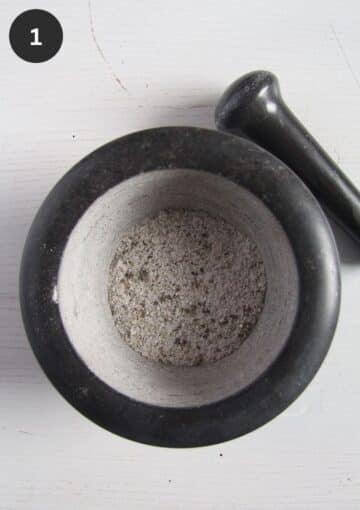
Step #1: Crush salt, peppercorns, and juniper berries in a mortar and pestle or in a small food processor. Add thyme.
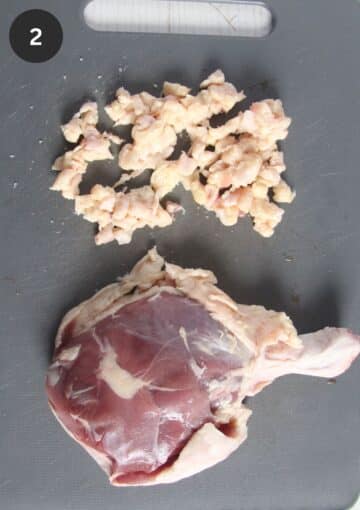
Step #2: Trim the excess fat from the underside of the duck legs.
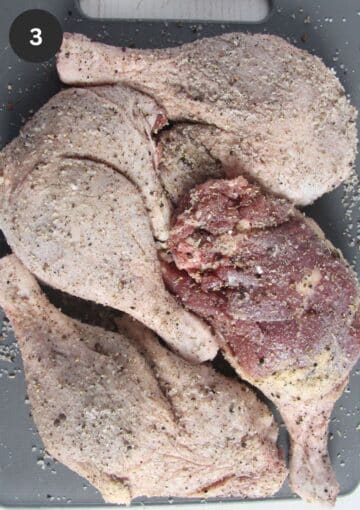
Step #3: Thoroughly rub the duck legs with the salt mixture.
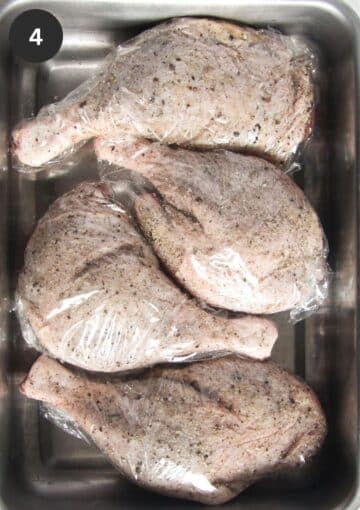
Step #4: Wrap each leg into plastic foil/cling film and refrigerate for 24 hours or up to 2 days.
Should you wash or not wash away the salt?
Some recipes suggest removing the salt mixture from the duck legs by rubbing it off with a cloth instead of washing it to avoid rehydrating the meat. I tried this and found the meat too salty. Fortunately, I only used this method on one leg.
Other recipes recommend washing the legs and soaking them in cold water for 2-3 hours.
I chose a middle ground by washing and thoroughly drying the duck legs before cooking them in fat. This resulted in slightly salty, delicious meat with super crispy skin.
Cook the duck legs in fat
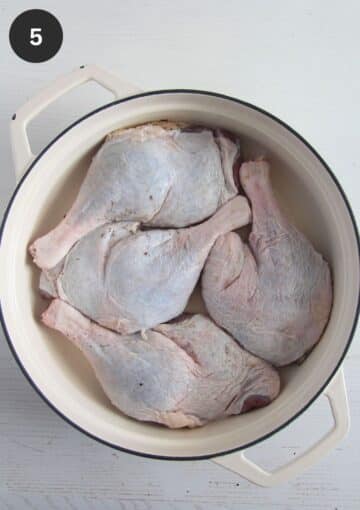
Step #5: Place the cured, washed, and dried duck legs in a large Dutch oven, large enough to hold them all snugly without leaving too much space between them.
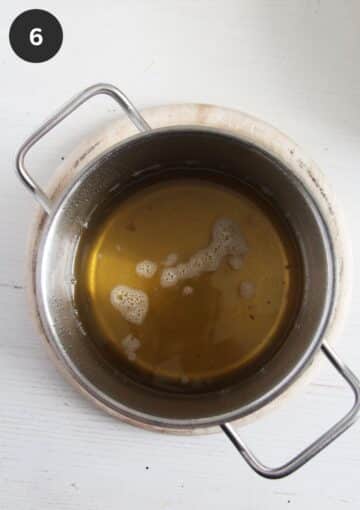
Step #6: Melt the fat in a jug saucepan.
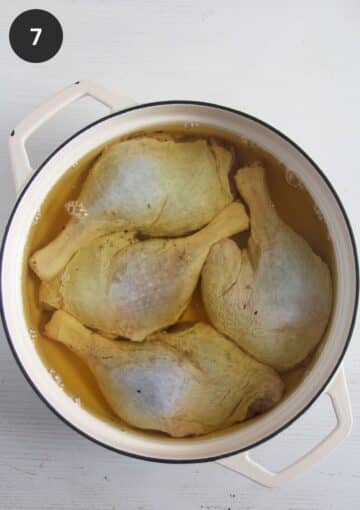
Step #7: Carefully pour it over the duck legs. If possible, check the temperature with a meat thermometer; it should be between 160 -175°F/ 70-80°C.
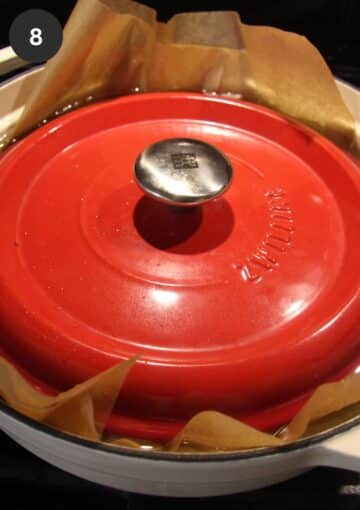
Step #8: To ensure that the meat stays submerged during cooking, place a piece of parchment paper directly over the meat and place a heavy lid (from a smaller Dutch oven) on top.
The legs must be placed in a single layer because the more space there is between them, the more fat you will need. Make sure that the meat is completely submerged in the fat.
It is important that the temperature of the goose fat is always constant and about 175°F/ 80°C. The fat should only barely simmer and never boil. Reduce the heat to very low and cook the duck legs for 2 hours and 30 minutes.
Check the fat's temperature with the thermometer from time to time to ensure that it doesn't get too high.
The duck legs are done when you can easily pierce the meat with a fork.
How to fry the legs?
You can fry and serve the duck leg confit immediately or later. To serve them immediately, remove them from the fat, let them drain well on some kitchen paper, and fry them as instructed in the recipe.
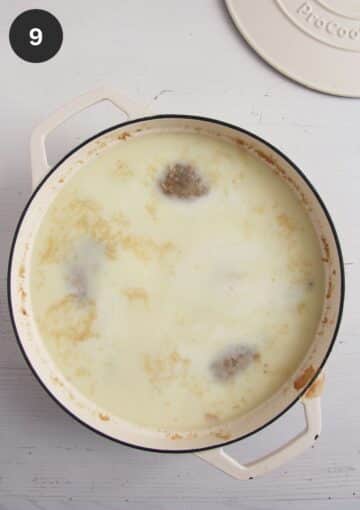
Step #9: If you want to serve the duck confit later, let the Dutch oven cool completely at room temperature. Then, cover it and place it in the refrigerator. The fat will preserve the meat for several days.
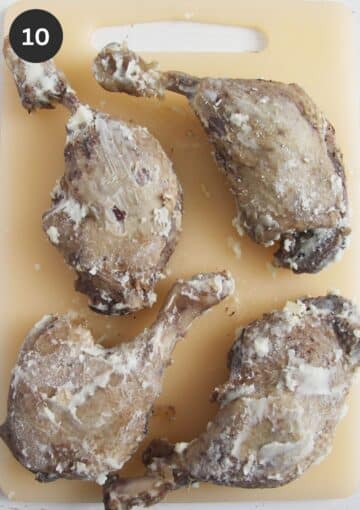
Step #10: Remove the legs from the fat and scrape away the fat. Fry them in a cast-iron skillet, skin side down, for 5 minutes or until the skin is deeply golden and crispy. Fry them on the other side for another 5 minutes.
How to preserve duck confit?
If you want to keep the duck leg confit for longer, transfer the legs to a large canning jar.
Sieve the melted fat to remove any impurities, let it cool for about 5 minutes, and pour the fat over the duck legs. Make sure that the duck legs are completely submerged in fat; the fat should top the meat by at least 1 inch/ 2.5 cm.
If kept in sealed jars the duck confit will keep in the fridge for a couple of months. If kept in a plastic container, it will keep in the fridge for a couple of weeks.
What to do with confit duck leftovers?
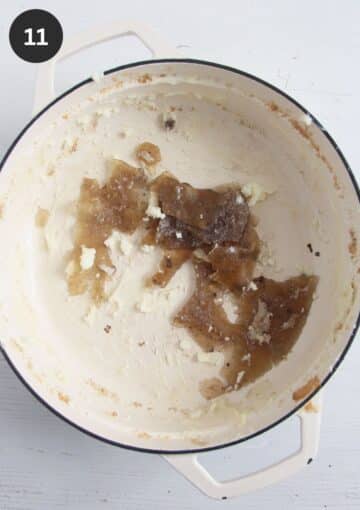
The layer of jelly at the bottom of the pot, under the fat. Keep it in a jar in the fridge for about a week. Use it to enrich sauces, stews, or soups; it will dissolve and add incredible flavor.
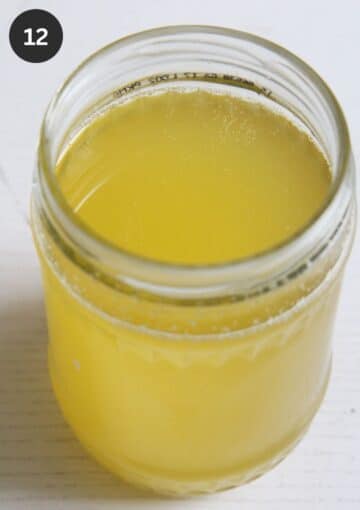
Leftover fat: Reheat it until liquid, then sieve it and pour it into jars once slightly cooled. Keep it refrigerated and use it for cooking.
Keep the meat submerged in fat if you want to serve it the same way. Otherwise, you can fry them and add them to salads and make noodles, rice, or potato casseroles.
Fat: Make confit potatoes or potatoes and eggs fried in duck fat.
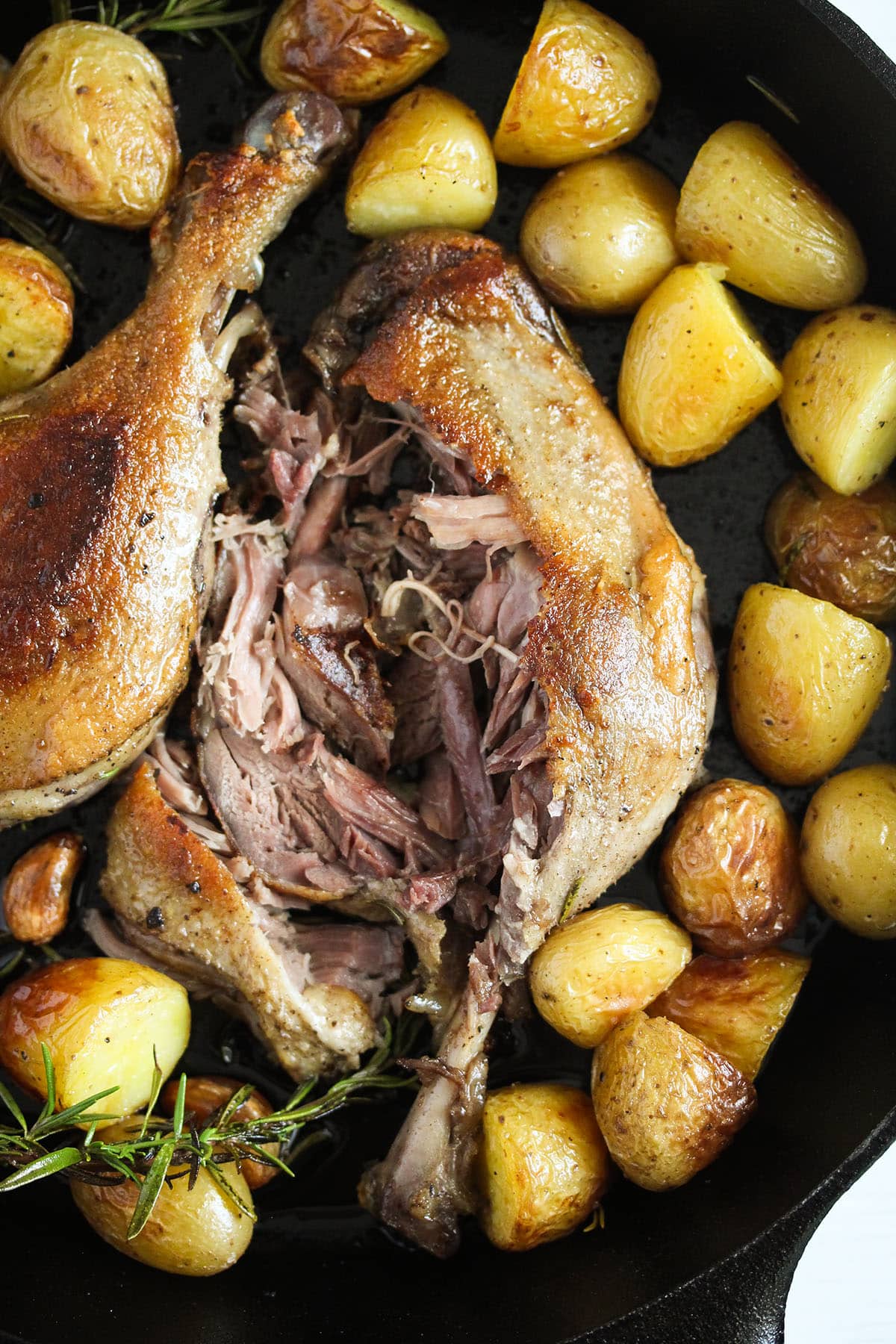
How to serve the duck legs?
Four duck legs can generously feed four people. A leg might be too much for some, but slicing and dividing one leg at the table isn't ideal.
With a soup or appetizer before the main dish (and a dessert), four legs can feed 6-7 people. In this case, slice the duck legs in the kitchen, remove the meat from the bones, and serve it boneless.
My common sides for confit de canard are roasted potatoes and a green salad with vinaigrette. Other great ideas are Slow Cooker Roast Potatoes, Truffle Mashed Potatoes, Roasted Leeks, French-Style Green Beans, or Sweetheart Cabbage.
Notes on the nutritional information
When calculating the nutritional information for this duck confit, I only considered 3 tablespoons of fat. Although the legs are cooked in over one kilogram of fat, most of it is leftover, making it impractical to include in the calculation.
I couldn't find reliable nutritional information from other sources to compare my calculations. The only data I found was 385 calories per portion, but this was based on dividing 4 duck legs and 4 wings into 26 portions.
Keep in mind that confit de canard is a very rich dish with more calories than a regular meal, but every calorie is worth it! This is a festive dish, not something to eat regularly.
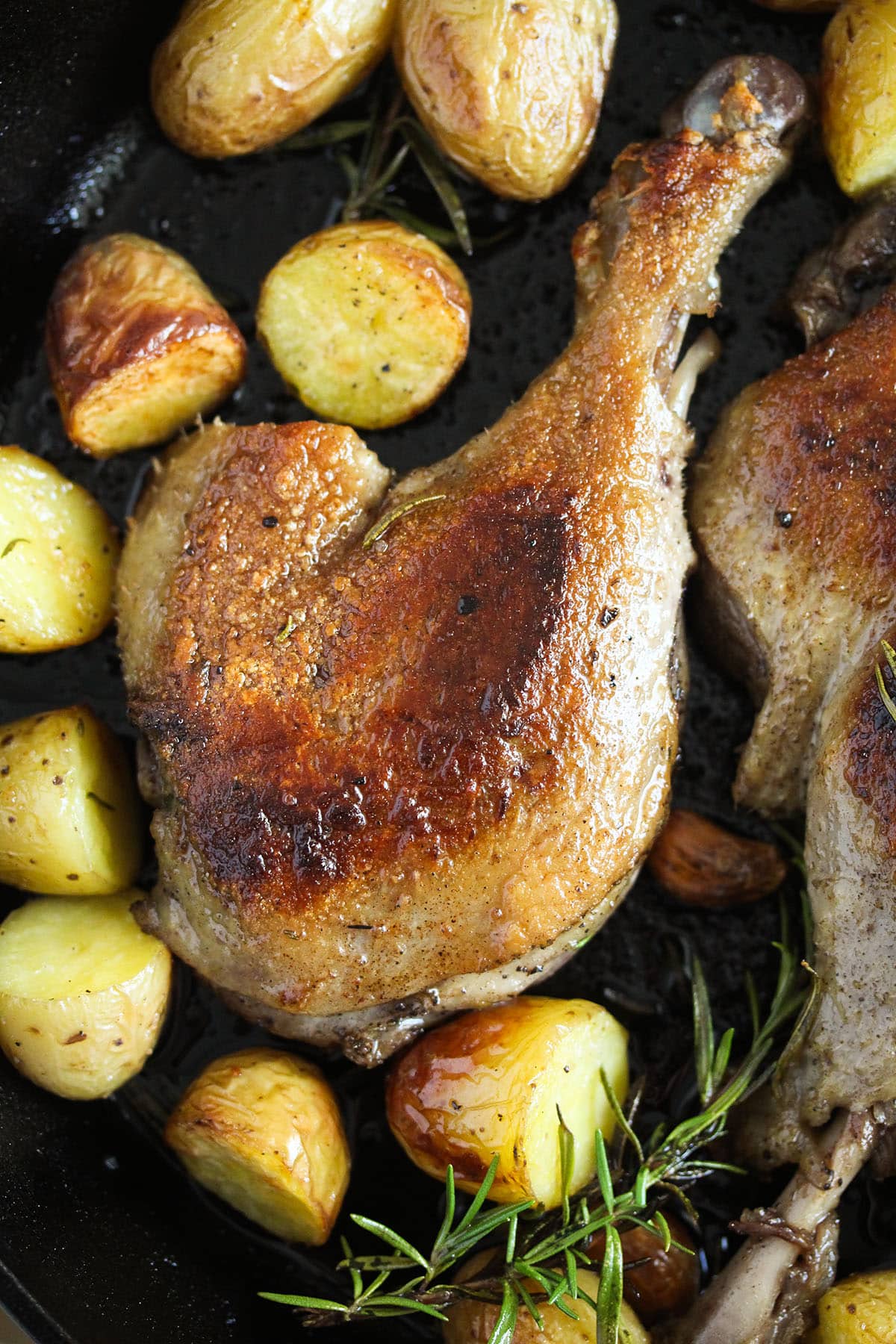
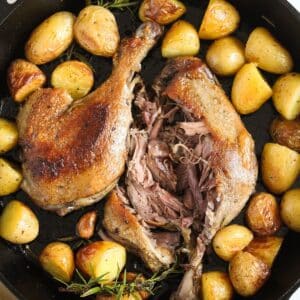
Confit de canard recipe (Duck Confit)
Equipment
- Large pot for making confit
- Cast iron skillet for frying the duck
- Small pot
Ingredients
- 4 duck legs
- 3 lbs duck fat 1.3 kg, Note 1
- 3 tablespoons coarse sea salt 50 g
- 1 teaspoon black peppercorns
- 1 teaspoon juniper berries
- 1 teaspoon dried thyme
Instructions
Cure:
- Seasoning: Crush the salt, peppercorns, and juniper berries in a mortar and pestle or in a small food processor. Add the thyme and stir well.3 tablespoons coarse sea salt + 1 teaspoon black peppercorns + 1 teaspoon juniper berries + 1 teaspoon dried thyme
- Cure duck legs: Trim the excess fat from the underside of the duck legs. Thoroughly rub the duck legs with the salt mixture. Wrap each leg in plastic foil/cling film and refrigerate for 24 hours or up to 2 days.4 duck legs
Duck confit:
- Assemble duck confit: Wash and dry the duck legs. Place in a large Dutch oven, large enough to hold them all snugly without too much space left in between. They have to sit in a single layer, but the more space in between, the more fat you will need.
- Cover with fat: Melt the fat in a jug saucepan and carefully pour it over the duck legs. Check with a kitchen thermometer if possible, the temperature of the fat should be between 160 -175°F/ 70-80°C.3 lbs duck fat 1.3 kg
- Make sure that the meat is completely submerged in the fat. To ensure that the meat stays submerged during cooking, cut a piece of parchment paper, place it directly over the meat, and place a heavy lid (from a smaller Dutch oven) on top.
- Temperature: It is very important that the fat's temperature is always constant and about 175°F/80°C. The fat should only barely simmer and never boil.
- Cook confit de canard: Reduce the heat to very low and cook the duck legs for 2 hours and 30 minutes. Check the temperature of the fat with the thermometer from time to time to make sure that it doesn't get too high. The duck legs are done when you can easily pierce the meat with a fork.
Fry the duck legs:
- To fry the duck legs, heat a large cast-iron or non-stick pan over medium heat. Add the duck legs, skin side down, and fry for 5 minutes or until the skin is deeply golden and crispy. If you notice that the skin turns too dark too soon, lower the heat slightly.
- Flip the legs and fry them for another 5 minutes or until deeply golden. Serve as suggested above.
Preserve confit de canard:
- Transfer the legs to a large canning jar.
- Sieve the melted fat to remove any impurities, let it cool for about 5 minutes, and pour the fat over the duck legs. Make sure that the duck legs are completely submerged in fat; the fat should top the meat by at least 1 inch/ 2.5 cm.
- Storage: If kept in sealed jars the duck confit will keep in the fridge for a couple of months. If kept in a plastic container, it will keep in the fridge for a couple of weeks.

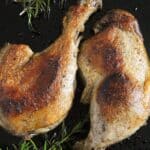
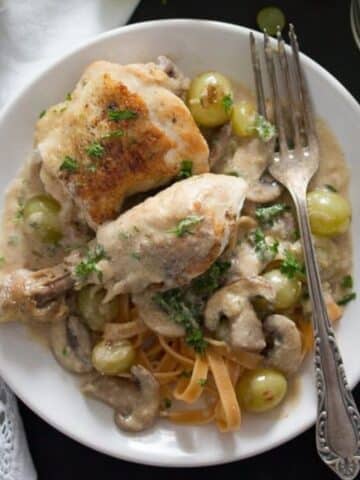
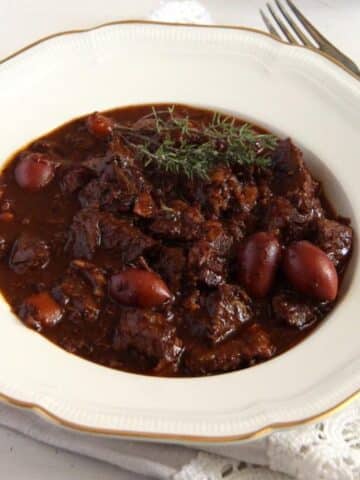


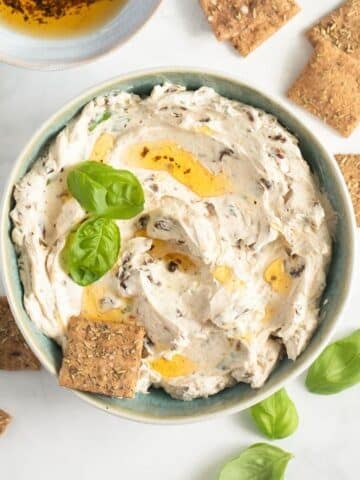
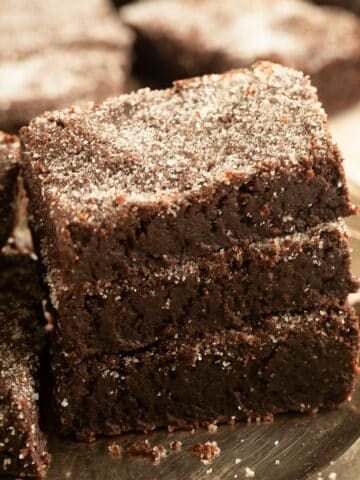
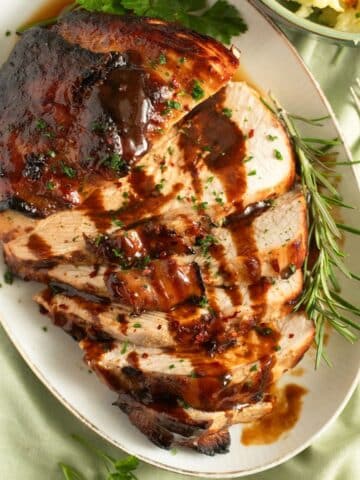
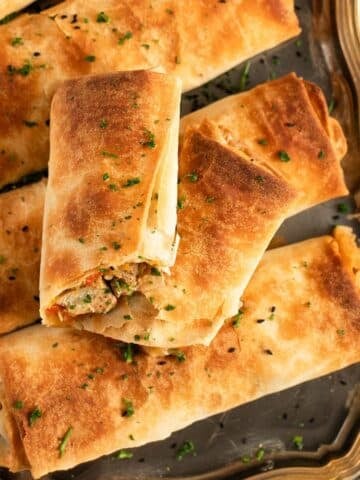

Fountain Of Joy says
Hm ... every other duck confit recipe I've seen calls for the cure to also contain onions, shallots, and garlic, and cooks in the oven for about 4 hours at 225 ... I kept trying to figure out what temperature you had the oven at, it took me a while to understand that you were cooking it on the stove! Might be interesting to try it with just the herbs. (I'll still probably bake it because I don't trust myself to cook things for a long time on the stove without overheating them, but it's interesting that it cooks so fast!)
marie johson says
i've tried this recipe and loved it. thanks for sharing 🙂
Kelly | Foodtasia says
What a lovely dish and so perfect for special occasions! Your step by step instructions are very helpful!
angiesrecipes says
wow...that turned out so beautifully golden and I bet they are very very yummy! I shall give this a try too.
mjskitchen says
Duck confit is my absolutely favorite dish! When I see it on a menu, I order it. Unfortunately, I've never been brave enough to make it. thank you for such detailed instructions. Now I think I could make this at home and not have to pay an arm and a leg at a restaurant. Hope you and your family have a wonderful holiday season!